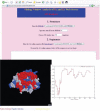SWAKK: a web server for detecting positive selection in proteins using a sliding window substitution rate analysis
- PMID: 16845032
- PMCID: PMC1538794
- DOI: 10.1093/nar/gkl272
SWAKK: a web server for detecting positive selection in proteins using a sliding window substitution rate analysis
Abstract
We present a bioinformatic web server (SWAKK) for detecting amino acid sites or regions of a protein under positive selection. It estimates the ratio of non-synonymous to synonymous substitution rates (K(A)/K(S)) between a pair of protein-coding DNA sequences, by sliding a 3D window, or sphere, across one reference structure. The program displays the results on the 3D protein structure. In addition, for comparison or when a reference structure is unavailable, the server can also perform a sliding window analysis on the primary sequence. The SWAKK web server is available at http://oxytricha.princeton.edu/SWAKK/.
Figures

Similar articles
-
Selecton 2007: advanced models for detecting positive and purifying selection using a Bayesian inference approach.Nucleic Acids Res. 2007 Jul;35(Web Server issue):W506-11. doi: 10.1093/nar/gkm382. Epub 2007 Jun 22. Nucleic Acids Res. 2007. PMID: 17586822 Free PMC article.
-
WSPMaker: a web tool for calculating selection pressure in proteins and domains using window-sliding.BMC Bioinformatics. 2008 Dec 12;9 Suppl 12(Suppl 12):S13. doi: 10.1186/1471-2105-9-S12-S13. BMC Bioinformatics. 2008. PMID: 19091012 Free PMC article.
-
PR2ALIGN: a stand-alone software program and a web-server for protein sequence alignment using weighted biochemical properties of amino acids.BMC Res Notes. 2015 May 7;8:187. doi: 10.1186/s13104-015-1152-6. BMC Res Notes. 2015. PMID: 25947299 Free PMC article.
-
State-of-the-art bioinformatics protein structure prediction tools (Review).Int J Mol Med. 2011 Sep;28(3):295-310. doi: 10.3892/ijmm.2011.705. Epub 2011 May 23. Int J Mol Med. 2011. PMID: 21617841 Review.
-
Characterization of protein structure and function at genome scale with a computational prediction pipeline.Genet Eng (N Y). 2003;25:269-93. doi: 10.1007/978-1-4615-0073-5_12. Genet Eng (N Y). 2003. PMID: 15260242 Review. No abstract available.
Cited by
-
Conserved C-terminal nascent peptide binding domain of HYPK facilitates its chaperone-like activity.J Biosci. 2014 Sep;39(4):659-72. doi: 10.1007/s12038-014-9442-z. J Biosci. 2014. PMID: 25116620
-
Detecting clusters of mutations.PLoS One. 2008;3(11):e3765. doi: 10.1371/journal.pone.0003765. Epub 2008 Nov 19. PLoS One. 2008. PMID: 19018282 Free PMC article.
-
Identification and Evolution of the WUSCHEL-Related Homeobox Protein Family in Bambusoideae.Biomolecules. 2020 May 9;10(5):739. doi: 10.3390/biom10050739. Biomolecules. 2020. PMID: 32397500 Free PMC article.
-
Evidence for conserved function of γ-glutamyltranspeptidase in Helicobacter genus.PLoS One. 2012;7(2):e30543. doi: 10.1371/journal.pone.0030543. Epub 2012 Feb 14. PLoS One. 2012. PMID: 22348013 Free PMC article.
-
Identification and Characterization of ATP-Binding Cassette Transporters in Chlamydomonas reinhardtii.Mar Drugs. 2022 Sep 25;20(10):603. doi: 10.3390/md20100603. Mar Drugs. 2022. PMID: 36286426 Free PMC article.
References
-
- Graur D., Li W.H. Fundamentals of Molecular Evolution. 2nd edn. Sunderland, MA: Sinauer Press; 2000.
-
- Li W.H., Wu C.I., Luo C.C. A new method for estimating synonymous and nonsynonymous rates of nucleotide substitution considering the relative likelihood of nucleotide and codon changes. Mol. Biol. Evol. 1985;2:150–174. - PubMed
-
- Nei M., Gojobori T. Simple methods for estimating the numbers of synonymous and nonsynonymous nucleotide substitutions. Mol. Biol. Evol. 1986;3:418–426. - PubMed
-
- Li W.H. Unbiased estimation of the rates of synonymous and nonsynonymous substitution. J. Mol. Evol. 1993;36:96–99. - PubMed
-
- Pamilo P., Bianchi N.O. Evolution of the Zfx and Zfy genes: rates and interdependence between the genes. Mol. Biol. Evol. 1993;10:271–281. - PubMed
Publication types
MeSH terms
Substances
Grants and funding
LinkOut - more resources
Full Text Sources

